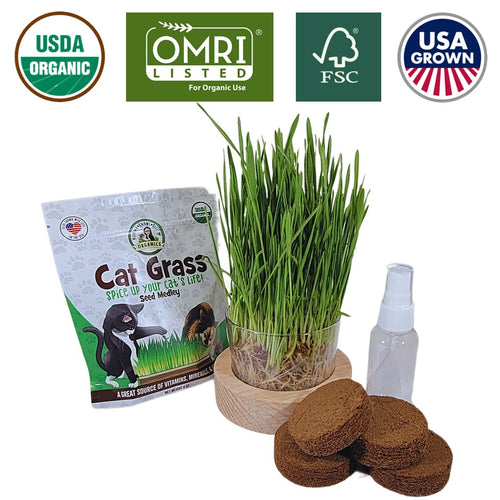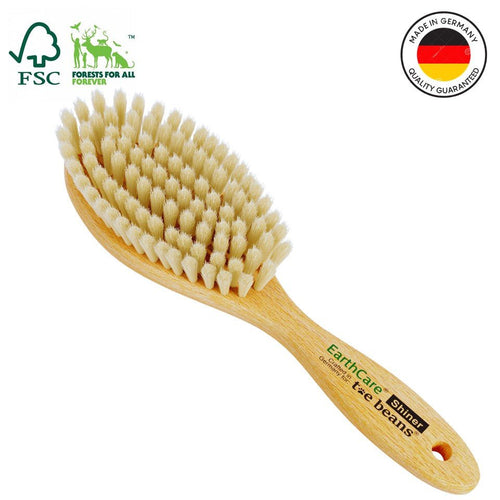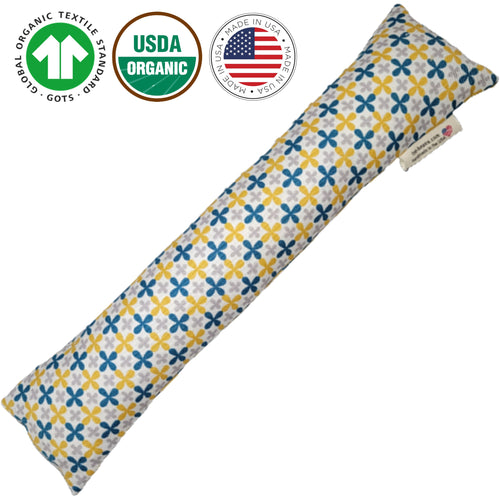Your Cart is Empty
Free 2-5 day delivery | No minimum purchase required
Free 2-5 day delivery | No minimum purchase required
Shop
Learn
The Ultimate Guide to Keeping Your Cat’s Paws Healthy
 by K Marie Alto Updated
10 min read
by K Marie Alto Updated
10 min read

Many of us tend to think of cats as independent creatures capable of taking care of themselves. In fact, as the meme goes, they're not so much pets as they are cohabitants we feed and who reward us with purrs and cuddles… when they feel like it.
The reality is that our furry little friends do need care from time to time, and to keep them as healthy and as comfortable as possible, we should keep an eye on various aspects of their health. Whether it's dental health, the occasional bath, or checking the litter box for signs of illness, it's something we have a responsibility to do as long as they're in our care.
Another element of cat health to watch is their paws. We want to keep those adorable little toe beans as healthy as possible, and that means keeping an eye on them and taking action when something needs attention.
What should you watch for, and if you see a problem, how do you take care of it? Read on to find out.
Table of Contents
Understanding the Cat's Paw
First up, let's talk a little about the different elements of the anatomy of a cat's paw. After all, those little toe beans have a purpose beyond just being cute!
A cat's paw is kind of like our hands or feet. Bones inside the paw are a lot like our finger bones; the first bit of digit where we have nails has their claws and curls up, while the second is flat and serves to support their weight. Because of this and their unique tendons and muscles in the foot, they are very flexible and can be maneuvered in a lot of different ways.
Speaking of the claws, most cats have claws at the end of each toe, which they can keep curled back or spread out and down if they want to knead or claw into something. Most animals can't retract their nails in the same way! Cats are mostly unique in this respect.
Note: This is also why "declawing" a cat is inhumane and cruel. It's not just cutting their claws off; it's cutting off that whole final digit. It would be like someone deciding your nails were too long and cutting off your fingertips to prevent them from growing. Awful!
Why do cats retract their claws? To protect them! If you've ever looked at a dog's nails, they tend to get worn down over time through contact with the ground, so they aren't very sharp or useful for defense. Cats keep their claws sharp because they're predators, and those claws are both a way to hunt and a way to defend themselves against other cats or larger predators.

Cat claws also grow sort of like the rings of trees. When they scratch at a scratching post, tree, or other material, they're doing it for a few reasons. One of those is to shed the outer layers of the claw, which removes chipped and dull outer layers and reveals the sharper, stronger inner layers.
Scratching also serves as a territorial marker; scent glands in their paws leave pheromones behind, and the physical damage is also a marker.
The toe beans themselves – more specifically known as paw pads – are soft, fatty tissue that is covered by a thick layer of skin. They serve as a grip for running and climbing, as cushioning for running and jumping, and even as a way to keep your kitty cool since they're one of the only places where a cat can sweat.
Some cats also have an extra toe or even several extra toes. This is a genetic condition called polydactyly. The world record that we know of is cats with 10 extra toes across all four of their feet!
So, how do you care for these paws?
Caring for Cat's Paws
The good news is you don't actually have to do a lot.
Get your cat used to you handling their paws
The first thing you should do is train your cat to tolerate you handling their paws. Some cats don't really care if you're messing with their toes, while others will pull their paws away and tuck them under themselves or even leave and hide if you mess with them. You may need to do some basic training to get them to tolerate your meddling.

Fortunately, that training generally just involves giving them a treat while or after you handle their paws and doing so gradually enough that they get used to more and more intrusive handling until you reach the point that you can spread their toes and look at their claws.
What to look for
Once you can handle your cat's paws safely, what should you look for?

Once again, this is pretty simple, so you don't have to worry too much.
-
Check for dirt, sticks, stones, or other debris, specifically caught between toe beans or between toes.
-
Look for signs of injury, like cuts, burns, thorns or splinters, or other injuries. Often, you'll be able to tell if your cat has an injured paw because they won't want you to handle it compared to their other paws.
-
Check their claws and see if they need a trim. Trimming cat nails can be tricky but is often unnecessary as long as they can scratch something often enough. You may need to trim them more if you're doing something like using nail caps, though.
-
Watch for signs of infection. Swelling, pus, a foul odor, or discoloration can all be signs of something more than just a cut or scrape.
If you see any of these, you can take action to handle them.
How to care for what you find
Your cat will probably do a pretty good job of keeping their paws clean, but you can help, especially if they're prone to getting the fur around their toes all matted, or if debris gets caught, or if they're polydactyl and have a harder time keeping them healthy.

Simple cleaning doesn't need to be intense; a little cloth or a bit of cotton can wipe away anything stuck, and if need be, a little soap and water can help.
Minor injuries like cuts can be treated with a bit of soap and water as well. Don't use something stronger; if they need more care, you can bring them to the vet to have them checked. In very rare cases, they might need stitches or medication. The key here is that you don't want to hurt your kitty when you treat their injury because that makes them less likely to let you handle their paws in the future.
How to Protect Your Cat's Paws from Future Damage
Ideally, your cat won't be able to really hurt themselves in your home. Most cat paw injuries come from them getting into places they shouldn't – like a drawer where you keep your kitchen knives – or when they go outside and get into trouble.
Household injuries are more likely to be a broken claw because of the wrong kind of scratching post or a terrible accident like rolling a wheely chair over their paw.
The biggest things you can do to help keep your cat's paws safe involve removing hazards. If they can access anything they could cut themselves on, you should try to keep those things locked away or in places they can't reach.

As far as scratchers go, you should pick something that is stiff enough to keep their claws nice and sharp but not prone to causing damage itself.
People who just use wooden boards, for example, are more likely to find their cat has gotten a splinter.
The best options tend to be sisal-coated posts or stiff cardboard consumable boxes. Raw wood and other materials are more likely to cause problems.
If your cat doesn't scratch enough to keep their nails trimmed and sharp, or if they're polydactyl and need help with certain claws, or if you just want to be proactive about it, you can trim their nails yourself. I have a whole guide to trimming cat claws, so check that out if you need help!
Should you use a paw balm? Most people don't. They work best for dogs, and your cat will probably find it unpleasant and lick it off ASAP, so it might not do a whole lot. You can certainly try, though, especially if your kitty is prone to dry skin or minor cuts and other injuries.
When Should You Bring Your Cat to the Vet?
Any care-related task for your household animals has a chance to uncover something worrisome, but it can be difficult to figure out when it's something that can be left alone to heal or if it needs veterinary care.
Obviously, if there's a broken bone, a lot of blood that won't stop, or anything of that sort, it's time for a trip to an emergency vet. Those are pretty obvious issues, and it's generally clear when it's an emergency.

Smaller cuts and scrapes, punctures from thorns or similar, and the like? All of those can generally be handled at home. As long as it's not something that won't stop bleeding, that might need stitches, or that is really deep, it will heal over time.
You might need to force your feline friend to face the indignity of a sock or other protective measure to prevent them from licking it raw over and over, though.
Things like infections or other injuries that won't heal will deserve a vet trip, but on the "next few days" scale, rather than immediate emergency. Your vet should see it, and you might need a prescription cream or antibiotic, but it's unlikely to be life-threatening or in need of emergency care.
Cat Paw Care FAQ
Now, let's round things out with a few questions that didn't fit elsewhere. If you have a question we didn't cover, ask in the comments!
Do cats with extra toes need different care?
Polydactyl cats do need a little extra care, and it depends on how many extra toes they have and how they're positioned.

Mostly, you need to see if they have claws that never touch the ground. Those claws can get overgrown, which can cause pain and even infection, as well as catch on things as they run around. In extreme cases, they can even catch when your cat jumps off of something and hurt their leg or pull the claw out! Ouch!
Otherwise, care for cats with extra toes is pretty much the same: just keep them clean and watch for signs of infection or injury.
Do cats really need paw care or are we just being busybodies?
Sure they do! Yes, cats can live on their own outside without getting any care, but so could you; that doesn't mean you wouldn't prefer to have shelter and medical care, right?

Cats use their paws for all sorts of things, from running around to scooping through the litter box, and that means they can pick up all sorts of potential harm. While they can care for some of it, they can only do so much, and you want to be able to help them if they get injured or have an infection.
My kitty squirmed and I cut their nail too deep. Help!
Cutting a nail to the quick – the internal part where the blood vessels and nerves are still present – is painful and will bleed a lot. The downside is that your cat will probably immediately run from you and might distrust you the next time you want to trim their nails.

If they don't run, or if you can cajole them into coming back, styptic powder can help you stop the bleeding. After that, it's a matter of winning back their trust, so I recommend some good treats as well.
Do you need to trim a cat's fur around their paws?
Not at all! Unless your cat is a long-haired breed and is getting old enough that they can't care for their paws themselves, you can generally leave that fur alone.

It isn't just about trusting them to do it, either. Your cat has whiskers on their face, which help them find their way through narrow spaces, but they also have whiskers on their paws between their toes. These are for tactile feedback and situational awareness, and trimming them can disorient your cat until they get used to it.
So, there you have it! My guide to keeping your cat's adorable toe beans as healthy as possible. Did I miss anything? If so, let me know!
You’ve Read the Labels. Now Trust What’s Behind Them.
You already read ingredient lists. You already worry about what touches your cat’s skin, what they lick, and what they lay on. So do we.
That’s why the products we make at toe beans only contain the cleanest raw materials and ingredients backed by world-renowned third-party certifications such as USDA Organic, GOTS® Organic, Oeko-Tex®, and FSC® amongst others.
Our cat toys for example are handmade in the USA using the cleanest GOTS certified organic materials. Our cat beds offer the cleanest, cozy rest without hormone-disrupting fire retardants, and our cat grooming supplies soothe sensitive skin with non-toxic, organic ingredients.
We get it, with so many companies out there hiding behind "natural" buzzwords while sourcing the lowest quality raw materials from overseas, it’s hard to know who to trust.
At toe beans, we take a radically different approach. We are not afraid to fully disclose what’s in the products we make. Neither do we hide known cancer-causing ingredients in ingredient groups such as "natural fragrances," or "cleansing agents." Rather, we offer cat parents full transparency — down to the last thread. Every item comes with a product anatomy data sheet so you know exactly what’s in it.
We are proudly not an Amazon brand (see why here) and believe that every cat parent deserves honest, transparent, and safe options.
Explore our certified-safe cat supplies now.
K Marie Alto
K. Marie is an animal lover, wife, kitty mom, dog auntie, writer, and co-founder of Toe Beans, a proud American family-owned online boutique pet supplies store focused on the improvement of the life of furry family members via pet parent education, better products, and advocacy. She has over 20 years of experience as a pet momma. She loves sharing her personal journey and experience as a pet parent via her blog and Facebook page where she currently has more than 50K followers (@furrytoebeans) and counting :-). Read more
Leave a comment
Comments will be approved before showing up.
Also in Pet Parents Blog by Toe Beans

Guide: The Right and The Wrong Way to Pet a Cat
by K Marie Alto June 19, 2025 9 min read
Learn the right and wrong ways to pet a cat and improve your bond by avoiding common mistakes that might leave your furry friend feeling frustrated or annoyed.

What You Should Know Before Adopting a Lab Retriever
by K Marie Alto June 12, 2025 8 min read
Learn what to expect before adopting a Labrador Retriever with our guide on breed traits, health, and care to ensure a happy life with your new canine friend.

What You Should Know Before Adopting a French Bulldog
by K Marie Alto May 29, 2025 10 min read
Learn what to expect when adopting a French Bulldog, including their care needs, health issues, and tips to prepare for a happy life with your new companion.
Related Products

Cat Grass Growing Kit | Starter | USDA Organic Seeds | Grown in the USA
$25.99

Cat Brush | Tampico Fiber Bristles | Made in Germany
$14.99

Cat Kicker Toy | Organic | Handmade in the USA
$19.95
Recent Articles
- Guide: The Right and The Wrong Way to Pet a Cat June 19, 2025
- What You Should Know Before Adopting a Lab Retriever June 12, 2025
- The Ultimate Guide to Keeping Your Cat’s Paws Healthy June 05, 2025
- What You Should Know Before Adopting a French Bulldog May 29, 2025
- Strategies to Remove the Smell of Cat Urine Permanently May 22, 2025
- Top 9 Large Dog Breeds That Keep Shedding to a Minimum May 15, 2025
- Why Do Cats Hide? The Top 4 Causes Explained May 08, 2025
- What You Should Know Before Adopting a Pit Bull Lab Mix May 01, 2025
- What To Expect When Introducing a Kitten to An Older Cat April 24, 2025
- The Guide to Dog Enrichment Toys for a Happier Pup April 17, 2025
